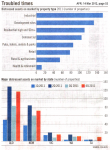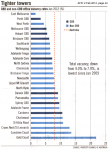 LAST WEEK, we explored just how the misuse of statistics by some commentators was distorting of the truth about Australia’s economic well-being, on a state-by-state basis.
LAST WEEK, we explored just how the misuse of statistics by some commentators was distorting of the truth about Australia’s economic well-being, on a state-by-state basis.
So it is with several other indicators, as David Bassanese pointed out in a recent article (AFR: 22 March, page 36).
Many commentators are pushing for interest rates reductions, because the “economy is soft”. And they list … [Read more…]






 Most pundits would point to the recent CPI figures and say “Yes”! And on the surface, an underlying inflation rate of 2.5% per annum is plumb in the middle of the RBA’s stated target zone.
Most pundits would point to the recent CPI figures and say “Yes”! And on the surface, an underlying inflation rate of 2.5% per annum is plumb in the middle of the RBA’s stated target zone.
 The banks seemed to be protesting about the increased cost of offshore borrowing. And using that as their excuse for not wanting to pass on any future RBA rate reductions in full.
The banks seemed to be protesting about the increased cost of offshore borrowing. And using that as their excuse for not wanting to pass on any future RBA rate reductions in full.











